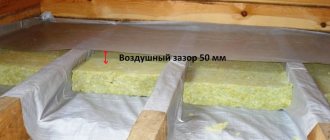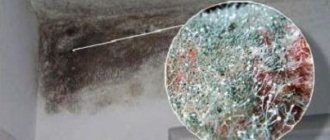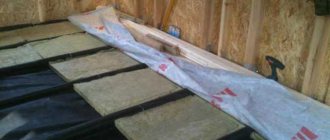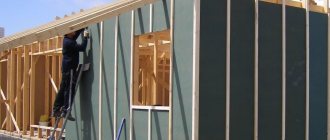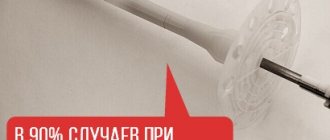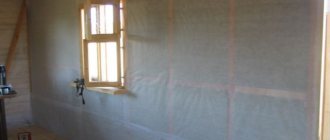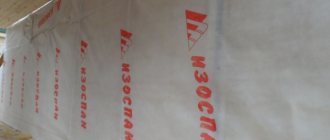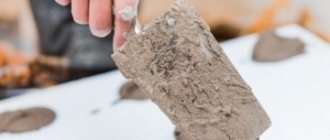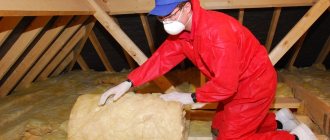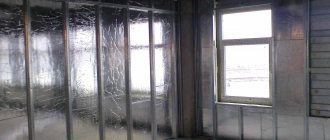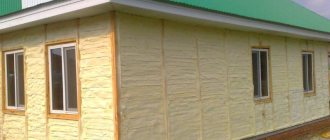Vapor barrier of a home is necessary for comfortable living. Applying a vapor barrier coating eliminates dampness and the development of mold and fungal microorganisms that are harmful to health.
High humidity leads to health problems; if the heating system does not work well, living in the house will be difficult to call comfortable. To prevent this, sufficient steam protection must be provided.
Installation process
Why is vapor barrier needed?
The air in residential premises contains many fine particles of moisture. They are formed due to natural needs. When cooking, bathing and other processes, steam is released. At low temperatures outside the window, warm air rushes out.
If the walls are not covered with thermal insulation material, heat escapes through the pores, and moisture settles on the structural elements. The lack of waterproofing contributes to the rotting of wooden elements and corrosion of metal elements. When using fibrous thermal insulation materials, they also accumulate liquid and lose their properties.
The problem is especially noticeable in frame houses, with many different materials. Steam passes through the insulation and settles on it. Moisture accumulates inside the wall.
Why is this necessary?
Of course, you can always find some excuse and skip the important stage of waterproofing the walls in your wooden house with peace of mind. However, very soon such negligence will make itself felt - already in the coming cold season, when moisture will constantly fall on the walls and penetrate into the structure of the wood. As a result:
- moisture accumulates;
- pathogenic flora arises;
- wood rots;
- the risk of partial destruction of the structure increases;
- there is a threat to life for all inhabitants of the house.
) moisture poses a serious threat by penetrating the wood base from the inside.
As a result, all the same processes that we mentioned above are repeated. Therefore, waterproofing of walls should be not only external
, but also
internal
- in this case, you can confidently talk about the full protection of the house and sleep peacefully.
Is it necessary to install it?
Sometimes you may not need to install a vapor barrier. If the frame is built from durable timber, dried to a minimum level of humidity. The connecting elements must fit as tightly as possible. This way the structure will be protected from moisture.
A number of risks remain:
- Due to the specific nature of wood as a material, fibrous and porous, at high humidity it serves as a medium for the development of pathogenic microflora.
- If you varnish, after a few years the treatment will become ineffective. After 5-10 years, moisture will begin to penetrate deep into the timber.
- If the house is for permanent residence, installation of waterproofing is required. This will prevent the walls from rotting from the inside from moisture generated during cooking and other household needs.
What types of vapor barrier materials are there?
There are many types of vapor barriers on the building materials market. Most are synthetic, obtained by polymerization. Natural fibers absorb moisture well.
Kinds
The main indicator of the quality of membranes and waterproofing films is vapor permeability. It depends on the amount of water passed through a square meter of vapor barrier in 24 hours. For high quality materials the figure does not exceed 20 g/m.
To assess the advantages and disadvantages of a particular material, we proceed from:
- service life;
- tensile strength;
- breathability while retaining steam.
Some materials have a low level of oxygen permeability. Therefore, constant ventilation of the room is required.
Popular:
- Polyethylene films are cheap and easy to install. They are characterized by low strength and a weak level of protection.
- Reinforced polyethylene has great strength and is affordable. Poor air permeability.
- Polypropylene film is durable and durable. The advantage is the price.
- Membranes for vapor barriers are ideal in more ways than one, except price. It is several times superior to its analogues.
- Izospan is stronger than propylene. But it practically does not allow oxygen to pass through.
Izospan
Where to order and how much does wall vapor barrier cost?
Material for insulation and vapor barrier of wooden walls can be purchased at hardware stores. The widest possible selection is available in specialized hypermarkets. In addition, you can order a vapor barrier on the Internet, but you will only be able to see the quality of the product with your own eyes upon receipt of your purchase. How much does vapor barrier cost for the walls of a wooden house? Below is a table with examples of prices for materials from different manufacturers.
| Brand | Type of material | Approximate cost per roll |
| Axton | Polypropylene film | About 600 rub. |
| Tyvek | Diffusion membrane | 4500-5000 rub. |
| Izovek | Polypropylene film | 800 rub. |
| Rockwool | Polypropylene film | 1100 rub. |
| Tyvek | Diffusion membrane | From 3500 rub. |
| TechnoNIKOL | Foil | 1100 rub. |
| Yutafol | Polyethylene film | 2500 rub. |
Types of vapor barrier membranes
Membranes for waterproofing are a synthetic material, different from analogues. Has advantages:
- The steam throughput is 10g/sq.m. m.
- Do not suffer from sudden changes in temperature.
- Due to their high rigidity they have a long service life.
- Do not interfere with gas exchange.
- Due to surface pores, they prevent contact of the insulation with steam.
Functions can be divided into:
- Anti-condensation – which prevents the penetration of condensate.
- Covered with foil for additional heat retention.
What types of membranes can be used
Waterproofing coatings are classified:
- A and AM - ensures the safety of the heat insulator from weather factors.
- Types B and C – protects from the inside of the building.
- Type D is a floor covering that prevents condensation from penetrating into the building.
Type A
This type of vapor barrier is intended for external protection of walls. Installation is carried out on:
- Shafts for air circulation.
- Under the roof.
- Under wall cladding.
Membranes
are attached between the sections of the sheathing so that liquid can drain. At the same time, it is important to create a slope so that the water drains.
Type AM
The purpose is similar to the previous type. Consists of a diffuse film and layers of polymers. Due to the structure of the steam comes out from the inside, the film completely blocks its penetration. No clearance required for ventilation.
Type B
To protect against moisture from the inside. Installed under the roof if you plan to place the attic in the attic. It is used for insulating floors and ceilings between tiers.
Type C
Vapor barrier for internal use, two-layer membrane. The purpose is similar to type B. Additionally used in the following rooms:
- attics;
- basements;
- ground floors;
- utility rooms.
Type D
Durable polypropylene layer. Installed in floors and under roofs. When used, it is required to withstand a high level of load. Reinforced with a laminating layer.
Carrying out installation work
Installation of vapor barrier is carried out after laying the insulation and before finishing the elements of building structures (wall, facade, floor, etc.).
General rules when performing work in a wooden house
In order for the vapor barrier to serve for a long time and in accordance with the requirements, it is necessary to follow the following rules for performing installation work, such as:
- When using film, fiberglass and roofing felt, it is necessary to overlap the strips of material used.
- When using foil materials, the strips are laid end to end.
- To connect the laid strips and seal the joints, special adhesive tapes, both single-sided and double-sided, are used. The type of tape is determined in accordance with the location where the vapor barrier material is installed.
- To connect foil materials, aluminum tape or special films coated with foil are used.
- Foil materials are laid in a metallized layer inside the room.
- Using construction tape for connection and sealing is not advisable, because... this material is susceptible to peeling off when exposed to moisture and external mechanical influences.
- When using vapor barrier membranes, they are laid with the smooth side facing the insulation, and with the uneven (rough) side into the interior of the room where they are being installed. When insulating the facade, the rough side is directed towards the “street”.
Installation of vapor barrier for external insulation of a wooden house
When installing a vapor barrier on the outer wall of a house made of logs, the ventilation gap between the surface and the vapor barrier is the voids formed in the vertical plane between the rows of logs.
When using timber of various types (sawn, glued) and half-timber, before laying the vapor barrier layer, it is necessary to install the sheathing, for which a wooden strip with a thickness of 20.0 - 25.0 mm is used, located in increments of 1.0 meter along the perimeter of the wall.
Roof vapor barrier helps maintain an optimal microclimate in the building
The vapor barrier material is fastened using a construction stapler or galvanized nails with a wide head.
After laying the vapor barrier, a frame for laying insulation (lathing) is installed and the selected heat insulator is laid, waterproofing is done and the exterior finishing of the building facade is installed.
Installation of vapor barrier for internal insulation of a wooden house
When installing a vapor barrier indoors, the work is performed as follows:
- The surface is being prepared. To do this, dust and foreign objects are removed.
- The wood is treated with antiseptic compounds that ensure the safety of building structures when exposed to water and moisture (rotting, the formation of fungi and mold).
- The sheathing for installation of insulation is installed. Its dimensions and pitch must correspond to the dimensions of the material used.
- Insulation is being installed.
- A vapor barrier layer is installed over the sheathing. Fastening is carried out as with an external vapor barrier device.
- When using films of various types and foil materials, an air gap of 4.0 - 5.0 mm should remain between them and the insulation. When using vapor barrier membranes, they are laid directly on the insulation.
- Vapor barrier materials should be placed in tension, without sagging or folds.
- Surface covering and finishing are carried out.
Vapor barrier of walls in a wooden house allows you to maintain the most comfortable microclimate created by building structures made from natural, environmentally friendly raw materials, such as wood.
The costs of this type of work are not comparable with the positive effect achieved in the presence of a vapor barrier, both in relation to the service life of the building, its thermal conductivity, as well as the conditions of use and living.
How is a vapor barrier film attached?
There are several ways to secure a vapor barrier:
- construction stapler;
- duct tape.
If necessary, you can combine. Scotch tape is divided into categories, depending on its purpose:
- Izospan KL is a durable tape for fixing class A vapor barriers. Durable and stable. The service life reaches 10-20 years.
- Izospan KL+ is a durable material due to multi-layer, reinforced polymers. Used in cold climates.
- Izospan ML - convenient for complex surfaces, with junctions of pipes, ceilings, and other structural elements.
Installation instructions for vapor barrier coatings
The installation method is different. It depends on the type of construction of the house. For frame structures and timber buildings, different methods are used.
Installation is best done inside and outside the building. External vapor barrier is required for protection from wind. It must be installed on old buildings with cracks.
Installation process
Vapor barrier from inside
When installing an insulating layer inside rooms, it is worth considering that after water circulates over the surface, it must be discharged somewhere. Therefore, it is necessary to provide a small gap between the insulation and the vapor barrier.
To ensure vapor barrier you will need to do the following:
- If the structure is built from cylindrical timber, due to the rounded shape of the components, no gap is required for fluid movement. It is enough to attach the membrane to the logs.
- Then a wooden sheathing is built and interior finishing, such as plasterboard sheets, is attached.
- If the house is built of rectangular timber, when installing the insulating layer, the vapor barrier membrane should be attached to the sheathing. It is mounted to the walls at small intervals. It is required to install vertical or horizontal rows that hold the insulation. This method is suitable for frame houses.
Vapor barrier outside
If wind protection is needed, a vapor barrier layer must be placed under the surface of the sheathing. It is necessary to ensure a tight fit to the insulation.
The work process looks like this:
- The vapor barrier is mounted on a round beam in the same way as for internal installation.
- All joints must be secured with construction adhesive tape; if foil film is used, with metallized tape.
- In frame buildings or structures made of timber, it is necessary to erect a counter-lattice.
- Then secure the film with wooden slats at the same intervals as on the sheathing.
A special feature of external vapor barrier is the requirement for sufficient air permeability. Therefore, it is undesirable to use film made of polyethylene or propylene. Due to the inability to allow oxygen to pass through, the steam escaping from the house will be blocked by the external barrier and settle on surfaces, which promotes rot.
External waterproofing
Why do you need a vapor barrier?
Water in liquid and vapor form has a negative impact on building structures made of wood. Moisture gets inside the wood structure and destroys it, the wood rots, mold forms, thereby deteriorating the performance characteristics and reducing the trouble-free use of wooden structures.
The ability of wood to absorb moisture negatively affects its heat-insulating properties, and with periodic moistening and drying of wooden structures, the tightness of the joints decreases, thereby the walls, roofing and other elements of buildings become ventilated. To ensure the required thermal insulation regime and prevent the destruction of wooden structures, a vapor barrier layer is installed both indoors and outdoors, when installing insulation of the building facade.
Vapor barrier and insulation: what is the ratio
Waterproofing is necessary to protect the insulation. In order not to spend money on the purchase and installation of insulating materials on the frame. Sometimes it is enough to use a cheap film, and in some cases it is desirable to provide a sufficient level of vapor barrier. Since it is mounted under external coverings, sidings or linings, two options must be provided:
- If foam materials are used: polystyrene foam, polyurethane, installation of waterproofing is optional. They do not absorb moisture.
- If any type of wool is used, a waterproofing coating is required.
Waterproofing a house is a way to extend the life of walls. It is important to choose the right material and install it in the right direction. Otherwise, the reliability of the protection is not guaranteed.
